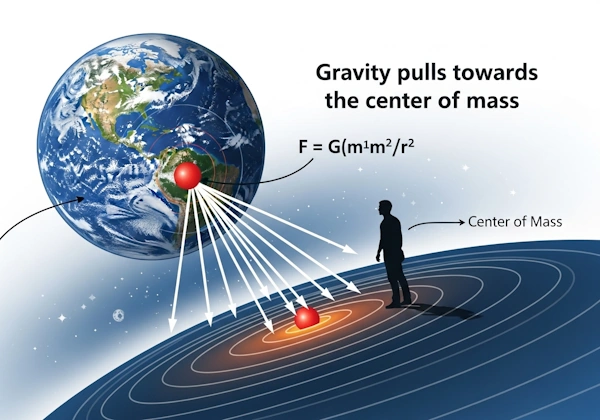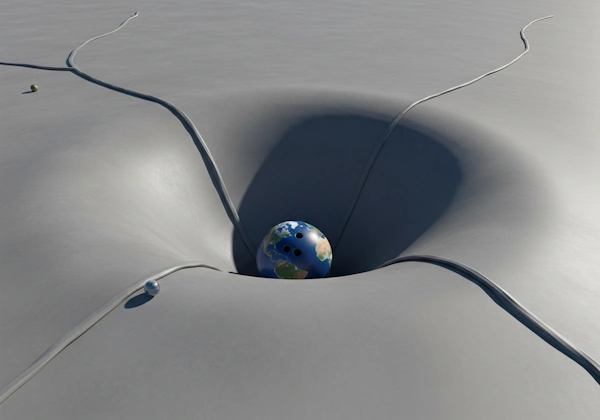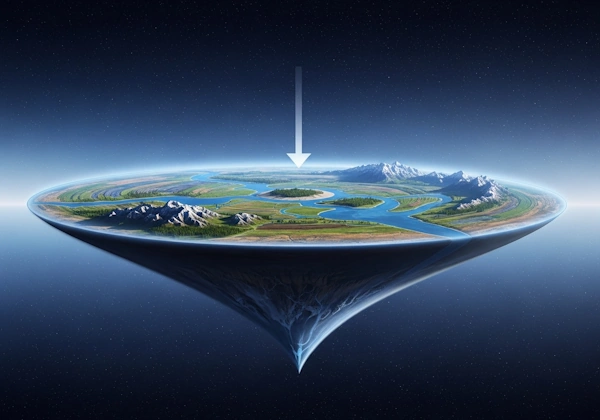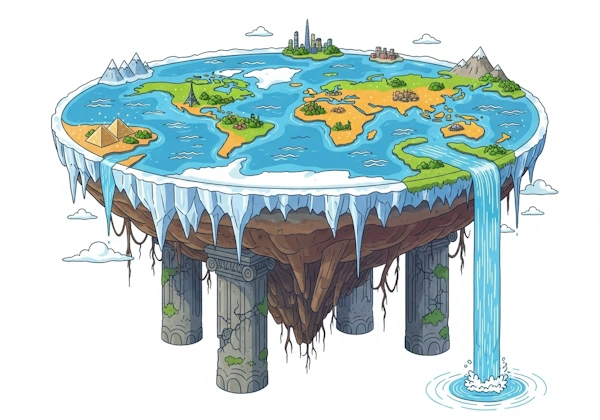You’ve probably encountered flat Earth arguments online, and maybe you’ve wondered: could there be something to these claims? Here’s what makes this question so scientifically interesting—it’s not just about Earth’s shape. It’s about understanding one of the universe’s fundamental forces: gravity. And when we dig deep into how gravity actually works, we discover something remarkable: the laws of physics themselves make a flat Earth impossible.
This isn’t about dismissing ideas without investigation. This is about following the evidence wherever it leads, using the same rigorous thinking that has taken us to the Moon, built GPS systems, and helped us understand black holes. By the end of this journey, you’ll see why the flat Earth theory doesn’t just lack evidence—it actually contradicts the fundamental forces that govern our universe.
Are you ready to explore some mind-bending physics?
- The Universe’s most familiar force
- The flat Earth gravity challenge: two impossible solutions
- Let’s test these ideas against reality
- The beautiful logic of spherical worlds
- Advanced physics: where flat Earth theory completely breaks down
- The consistency test: why science works
- Your journey into scientific thinking
- Your scientific adventure continues
The Universe’s most familiar force
Before we tackle flat Earth claims, let’s understand what we’re working with. Gravity seems simple—things fall down, right? But gravity is actually one of the most profound and elegant forces in nature, and understanding it properly will give you insights that reach far beyond our planet.
Newton’s revolutionary discovery
When Isaac Newton formulated his law of universal gravitation, he revealed something stunning about our universe: every single particle of matter attracts every other particle. Yes, you are gravitationally attracted to your phone, your desk, and even the person sitting across the room from you. The force is incredibly tiny between small objects, but it’s always there.
Here’s Newton’s mathematical description of this universal attraction:
F = G(m₁m₂)/r²
This elegant equation tells us that gravitational force depends on mass and distance. But here’s the crucial part that will matter for our flat Earth investigation: gravity always pulls objects toward each other’s center of mass. Not toward a flat surface, not in some arbitrary direction—always toward the center of mass.

Think about what this means for a moment. If you’re standing on Earth, gravity pulls you toward the center of our entire planet, which happens to be about 6,371 kilometers beneath your feet.
Einstein’s mind-blowing insight
Einstein took our understanding even further. He showed us that gravity isn’t really a force pulling on objects—it’s the curvature of space and time itself. Picture setting a bowling ball down on a tightly pulled rubber surface. The ball creates a depression, and if you roll a marble nearby, it will curve toward the bowling ball. That’s essentially how massive objects curve spacetime, and that curvature is what we experience as gravity.

This insight will become crucial when we examine flat Earth proposals, because Einstein’s description of gravity works in three-dimensional space around massive objects—naturally creating the spherical gravitational fields we observe.
The flat Earth gravity challenge: two impossible solutions
Now here’s where things get fascinating. If Earth were actually flat, how would gravity work? Flat Earth advocates have proposed two main explanations, and we’re going to put both through rigorous scientific analysis. What you’ll discover is that both solutions create problems that would fundamentally change reality as we know it.
The great acceleration hypothesis: breaking the Universe’s speed limit
The most popular flat Earth explanation claims that our flat disk is constantly accelerating upward at 9.8 meters per second squared. This acceleration, they argue, pushes against objects and creates the sensation we call gravity.
Let’s run the numbers and see what happens.
When mathematics meets reality
Here’s a question for you: what happens when something accelerates without stopping? Let’s calculate where this flat Earth would be after just one year of constant acceleration:
Starting from rest, accelerating at 9.8 m/s²:
- After 1 second: 9.8 m/s
- After 1 minute: 588 m/s
- After 1 hour: 35,280 m/s
- After 1 day: 846,720 m/s
- After 1 year: 309,253,200 m/s
Now, the speed of light—the absolute speed limit of our universe—is approximately 299,792,458 m/s.
Do you see the problem? After just 354 days of this supposed acceleration, our flat Earth would be traveling faster than light itself. And here’s where physics gets unforgiving: Einstein’s special relativity tells us that nothing with mass can reach light speed, let alone exceed it.
The energy crisis that breaks physics
But the problems don’t stop there. As objects approach light speed, something extraordinary happens: their mass effectively increases toward infinity. This means the energy required to keep accelerating also approaches infinity.
Think about this: what mechanism could possibly provide infinite energy to accelerate an entire planet? There’s no known physics that could accomplish this. We’re not talking about something that’s merely difficult—we’re talking about something that would require breaking the fundamental laws of energy conservation.
Time gets weird
Here’s where relativity makes things even more mind-bending. If Earth were somehow approaching light speed, time dilation effects would kick in. Time would literally run slower for us compared to the rest of the universe. After a year of this acceleration, we’d be experiencing time so differently from the rest of the cosmos that causality itself would break down.
Imagine trying to communicate with a space probe, or observe distant stars, when your reference frame is violating the fundamental structure of spacetime. The universe would look completely different than what we actually observe.
The center-pull disaster: when “down” isn’t down
Some flat Earth believers, recognizing the problems with constant acceleration, propose a different solution: gravity pulls everything toward the center of the flat disk, just like it pulls toward the center of a spherical planet.
This sounds more reasonable at first, but let’s think through what this would actually mean.
The geometry of catastrophe
On our spherical Earth, “down” is the same everywhere—it’s toward the center of the planet, which is always perpendicular to the surface beneath your feet. But on a flat disk, this creates a geometric nightmare.

Let me paint you a picture. Imagine you’re standing at different distances from the center of this flat Earth disk:
- At the center: Gravity pulls straight down. Everything seems normal.
- 3,000 km from center: Gravity now pulls at a 26.57° angle toward the center. You feel like you’re standing on a slanted hillside, even though the ground appears flat.
- 5,000 km from center: Gravity pulls at a 63.43° angle from vertical. You literally cannot stand upright without falling toward the center.
- At the edge: Gravity pulls almost horizontally. Standing is impossible.
Life in this impossible World
Let’s imagine what daily life would be like in this scenario:
- Your morning routine: If you live anywhere but the very center of the disk, your coffee doesn’t pour straight down into your cup—it pours at an angle toward the center of the world. Your shower water sprays diagonally across the bathroom. Every step you take feels like you’re walking uphill away from the center.
- Architecture becomes impossible: How do you build a house when gravity pulls sideways? Your walls would need to be angled to remain stable against the diagonal gravitational pull. Windows wouldn’t be rectangular. Doors wouldn’t hang straight.
- The great water migration: Here’s something that would be immediately obvious—all water on Earth would flow toward the center. Rivers, oceans, even the water in your swimming pool would constantly drain toward the center of the disk. The edges of the world would be dry, barren wastelands while the center would be covered by a massive ocean.
- Sports would be surreal: Imagine playing basketball when the hoop isn’t above you—it’s at an angle toward the center of the world. A dropped ball doesn’t fall straight down; it falls diagonally. Baseball would be impossible because the ball’s trajectory would constantly curve toward the disk’s center.
Let’s test these ideas against reality
This is where science gets exciting. We don’t just think about these scenarios theoretically—we can test them against what we actually observe.
The plumb bob experiment
Here’s a simple test you can do yourself. Take a weight and hang it from a string (this is called a plumb bob). Gravity will pull the weight in the direction of gravitational force—it always points “down.”
According to the center-pull flat Earth model, this plumb bob should hang at increasingly steep angles as you move away from the center of the disk. If you live 3,000 kilometers from the center, your plumb bob should hang at a 26.57° angle, not straight down.
But what do we actually observe? Plumb bobs hang straight down everywhere on Earth. This simple observation alone disproves the center-pull gravity model.
The uniform gravity discovery
Scientists have measured gravitational acceleration all over Earth using precise instruments. What they’ve found is remarkable: gravity pulls at approximately 9.8 m/s² straight down relative to the local surface everywhere on the planet.
This is exactly what we’d expect on a spherical Earth, where “down” means toward the planet’s center. It’s completely inconsistent with either flat Earth gravity model.
Water’s honest testimony
Water doesn’t lie about gravity—it always finds its level perpendicular to gravitational pull. On our spherical Earth, large bodies of water actually curve with the planet’s surface (the curvature is subtle but measurable).
On a flat Earth with center-pull gravity, water could never be level except at the exact center of the disk. Every lake, every ocean, every puddle would slope toward the center. Yet we observe stable, level bodies of water at all latitudes and longitudes.
The beautiful logic of spherical worlds
Now let’s explore why planets naturally form as spheres—and why this shape elegantly solves all the problems that plague flat Earth models.
Here’s something beautiful about gravity: it pulls equally from all directions toward an object’s center of mass. When matter accumulates in space, this equal pull from all sides naturally creates spherical shapes.
Think of it this way: if there’s a bulge anywhere on a forming planet, gravity pulls extra hard on that bulge, drawing it back toward the center. Over time, this process naturally smooths out irregularities and creates a sphere—the shape where every point on the surface is equidistant from the center of mass.
Why our Earth works so perfectly
On our spherical Earth, every single gravitational phenomenon makes perfect sense:
- Objects fall “down” because down means toward Earth’s center, which is always perpendicular to the local surface
- Water finds its level by conforming to Earth’s gentle curvature
- We can build straight walls because gravity pulls perpendicular to the ground everywhere
- Satellites maintain stable orbits because they’re falling around a spherical gravitational field
- Navigation works because we can use the predictable geometry of a sphere
The satellite reality check
Right now, thousands of satellites are orbiting above you, following precise elliptical paths calculated using the mathematics of spherical gravitational fields. Your GPS works because these satellites know exactly where they are relative to spherical Earth.
On a flat Earth, these orbits would be impossible. The complex, irregular gravitational field of a flat disk would cause satellites to crash or escape rather than maintain stable orbits. Yet GPS works with incredible precision—often to within a few meters.
Advanced physics: where flat Earth theory completely breaks down
Let’s push deeper into some advanced concepts that completely demolish flat Earth theory.
Tidal forces: gravity’s subtle signature
You’ve probably heard of ocean tides caused by the Moon, but do you understand what’s actually happening? The Moon pulls more strongly on the side of Earth closest to it than on the far side. This difference in gravitational pull stretches our planet slightly, creating the complex tidal patterns we observe.
This only works because Earth is spherical. On a flat disk, the Moon would create torques that would tend to flip the disk over rather than stretch it. The tidal patterns would be nothing like what we actually observe.
Seismic waves
When earthquakes occur, they send waves through our planet that we can detect on the opposite side of the world. The way these waves travel—their paths, timing, and properties—reveals Earth’s internal structure and confirms its spherical shape.
Some earthquake waves create “shadow zones” where they can’t be detected, caused by Earth’s liquid outer core refracting the waves. This phenomenon only makes sense in a spherical Earth and provides direct evidence of our planet’s internal structure.
The relativity connection
Einstein’s theories of relativity have been tested countless times and have never failed. They govern everything from GPS satellites to particle accelerators to our understanding of black holes. These theories are fundamentally incompatible with the constant acceleration model of flat Earth theory.
When a scientific theory contradicts relativity, it’s not just wrong—it’s contradicting one of the most thoroughly tested and successful theories in the history of science.
The consistency test: why science works
Here’s what makes science so powerful: real theories explain multiple phenomena consistently. Let’s see how our spherical Earth model performs:
✓ Gravity works uniformly everywhere
✓ Day and night cycles make perfect sense
✓ Seasons occur due to axial tilt
✓ Navigation systems work with incredible precision
✓ Satellite orbits are stable and predictable
✓ Tidal patterns match mathematical predictions
✓ Time zones follow longitude lines
✓ Different stars are visible from different latitudes
✓ Ships disappear hull-first over the horizon
✓ Lunar eclipses show Earth’s round shadow
✓ Seismic waves behave as predicted
✓ Weather patterns follow spherical geometry
Every single one of these observations fits perfectly with a spherical Earth. The flat Earth model, constrained by its impossible gravity scenarios, fails to explain most of these observations without resorting to increasingly complex and contradictory explanations.
Your journey into scientific thinking
What you’ve just experienced is how real science works. We started with a question, examined the proposed explanations, applied mathematical analysis, tested against observations, and followed the evidence to its logical conclusion.
This process has taken humanity from thinking Earth was the center of the universe to understanding our place in a cosmos containing billions of galaxies. It’s the same process that gave us medicine, computers, space travel, and every piece of modern technology you use daily.
The beauty of physical laws
What’s truly remarkable is that the same gravitational principles that disprove flat Earth theory also explain:
- Why planets form as spheres
- How binary stars orbit each other
- Why galaxies have the shapes they do
- How black holes bend space and time
- Why the Moon stays in orbit around Earth
Physics isn’t just a collection of facts—it’s a unified understanding of how the universe works. When we understand gravity properly, we understand something fundamental about reality itself.
Critical thinking in the information age
In our digital world, you’ll encounter many claims that sound plausible at first glance. The flat Earth investigation teaches you a crucial skill: how to distinguish between ideas that merely sound interesting and ideas that actually work when subjected to rigorous analysis.
Real scientific theories make specific, testable predictions. They explain multiple phenomena consistently. They work when you run the numbers. Pseudoscientific claims often sound compelling in isolation but fall apart when examined systematically.
The question of Earth’s shape isn’t a matter of opinion, belief, or perspective. It’s a question of physics. The fundamental forces that govern everything from falling apples to orbiting galaxies make a flat Earth physically impossible.
The evidence isn’t just compelling—it’s mathematically inevitable. Every aspect of gravity that you can measure, calculate, or observe points to the same conclusion: we live on a spherical planet in a universe governed by elegant physical laws.
But here’s what’s even more exciting than debunking flat Earth theory: through this investigation, you’ve gained insights into how the universe actually works. You understand why planets are round, how gravity shapes the cosmos, and why Einstein’s theories revolutionized our understanding of reality.
Your scientific adventure continues
This journey into the gravity problem is just the beginning. The same analytical thinking that disproves flat Earth theory can help you understand climate science, evaluate medical claims, analyze economic policies, or investigate any other complex topic you encounter.
You now have tools that can help you distinguish between real science and pseudoscience, between claims that work when tested and claims that merely sound convincing. In a world full of information, these tools are more valuable than ever.
The universe is far more amazing, elegant, and comprehensible than flat Earth theory suggests. We live on a beautiful spherical world, governed by mathematical laws so precise that we can predict eclipses centuries in advance, navigate spacecraft to distant planets, and understand the fundamental forces that shape everything from atoms to galaxies.
That’s not just more accurate than flat Earth theory—it’s infinitely more wonderful.
Welcome to the universe as physics reveals it. It’s been waiting for curious minds like yours to explore its mysteries.
Sources:
- Carroll, S.M. (2019) Spacetime and Geometry: An Introduction to General Relativity. Cambridge: Cambridge University Press.
- Feynman, R.P., Leighton, R.B. & Sands, M. (2013) The Feynman Lectures on Physics, Vol. 1: Mainly Mechanics, Radiation, and Heat. New York: Basic Books.
- Isaacs, A. (2000) Gravity: Newtonian, Post-Newtonian, Relativistic. Hackensack, NJ: World Scientific.
- Kipping, D. (2019) ‘Debunking Flat Earth with Newtonian Gravity’, Scientific American. Available at: https://www.scientificamerican.com/article/debunking-the-flat-earth-with-gravity/
- Kuhn, K. & Spitzer, R. (2008) The Spherical Earth: Evidence from Astronomy and Physics, Sky & Telescope, 116(6), pp. 28–33.
- Livio, M. (2012) Is God a Mathematician? New York: Simon & Schuster.
- Newton, I. (1687) Philosophiæ Naturalis Principia Mathematica.
- Tyson, N.D. (2017) Astrophysics for People in a Hurry. New York: W.W. Norton & Company.
- Van Duzer, C. (2010) ‘The Spherical Earth and Scientific Evidence’, Physics Teacher, 48(5), pp. 314–319.
- Wolf, J. (2018) Do We Really Live on a Sphere? A Scientific Guide to Debunking Flat Earth Claims. Berlin: Springer.

Leave a Reply